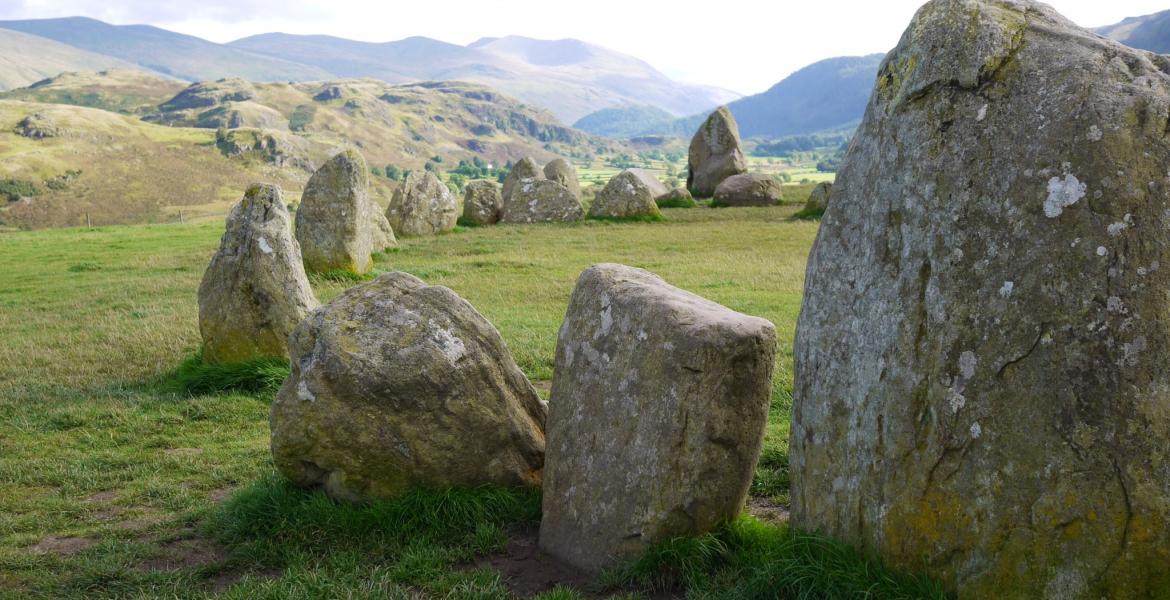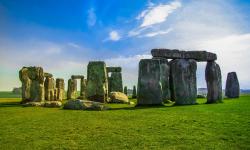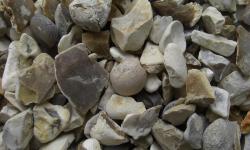The Chronology of the Stone Age
Key facts about the chronologyThe arranging of events in the order they occurred in time.The arranging of events in the order they occurred in time. of the Stone AgeThe earliest part of human prehistory, running from about 3.3 million years ago until (in Britain) about 2500BCE. It is defined by the use of stones (rather than metals) as tools.The earliest part of human prehistoryThe time in the past that happened before history began to be recorded., running from about 3.3 million years ago until (in Britain) about 2500BCE. It is defined by the use of stones (rather than metals) as tools.
- The Stone Age lasted from about 3.4 millions years ago until about 2500BCE
- The term 'Stone Age' covers several different eras
- Each era was different and witnessed different changes
The Stone Age is the period of human history that covers the time between the first use of stone tools through to the start of use of metallic tools. The term ‘Stone Age’ is somewhat arbitrary, as it suggests that humans used nothing other than stone tools. However, we know for a fact that other materials, such as bones and wood, were also used. It’s just that stone survives for much longer than organicSomething that is, or was, alive. material.
The first identifiable use of tools by humans is a tricky thing to establish, as the timing keeps getting pushed back. For several years, it was thought that the first tools emerged around 2.5 million years ago. However, over the last couple of years, this has been pushed back to 3.4 million years ago. What muddies the water further is that these tools probably weren’t produced by humans, but by our distant ancestors, the australopithecinesVery old ancestors of early human species. They have sometimes been called the missing link between apes and humans.Very old ancestors of early human species. They have sometimes been called the missing link between apes and humans.. Does this mean that we have to push back the date for the start of the Stone Age to include non-humans and, if so, what does this do to our idea of humanity?
The Stone Age covers a huge amount of time. Those studying the Stone Age therefore find it useful to break the period down into smaller sections. These sections are not distinct and are useful more as a way of thinking loosely about a very wide range of behaviours and technologies than (pardon the pun) being set in stone. It is possible to get MesolithicThe 'Middle Stone Age'. See 'The Chronology of the Stone Age'.The 'Middle Stone Age'. See 'The Chronology of the Stone Age'. behaviour in the PalaeolithicThe 'Old Stone Age'. See 'The Chronology of the Stone Age'.The 'Old Stone Age'. See 'The Chronology of the Stone Age'., as well as the other way around.
| Period | Timeframe | |
|---|---|---|
| Palaeolithic | Lower PalaeolithicThe earliest part of the Stone Age (3.4million years BP to 300000BP). See 'A Brief History of Climate Change'.The earliest part of the Stone Age (3.4million years BP'Before present', usually refers to up to 10,000 years BP, after which it switches to BCE. to 300000BP). See 'A Brief History of Climate Change'. | 3.4 million - 300,000 years ago |
| Middle PalaeolithicThe 'Middle Old Stone Age' (300000BP to 45000BP). See 'The Chronology of the Stone Age'.The 'Middle Old Stone Age' (300000BP to 45000BP). See 'The Chronology of the Stone Age'. | 300,000 - 45,000 years ago | |
| Upper PalaeolithicThe most recent part of the Old Stone Age, which runs from about 45000BP to 10000BP. See 'The Chronology of the Stone Age'.The most recent part of the Old Stone Age, which runs from about 45000BP to 10000BP. See 'The Chronology of the Stone Age'. | 45,000 - 11,600 years ago | |
| Mesolithic | 9600 BCE'Before common era', the non-religious way of saying 'BC' (which means 'before Christ'). - 4500 BCE | |
| NeolithicThe 'New Stone Age'. See 'The Chronology of the Stone Age'.The 'New Stone Age'. See 'The Chronology of the Stone Age'. | 4500 BCE - 2500 BCE | |
- Palaeolithic – this means the ‘old stone ageThe earliest part of human prehistory, running from about 3.3 million years ago until (in Britain) about 2500BCE. It is defined by the use of stones (rather than metals) as tools.’, and covers about 99 per cent of human time. It runs from the first identifiable use of tools by humans to about 10,000 years ago. As the period covers so much time, the Palaeolithic is split into three sections:
- The Lower Palaeolithic covers the first humans and possibly pre-humans (australopithecines) to about 300,000 years ago.
 Often the British Lower Palaeolithic begins with the first arrival of humans on the land of Britain. At the moment, this can be dated to around a million years ago, but new finds are constantly pushing this date backwards. This is when there seems to have been a change in technology (the types of stone tools change) and possibly culture.
Often the British Lower Palaeolithic begins with the first arrival of humans on the land of Britain. At the moment, this can be dated to around a million years ago, but new finds are constantly pushing this date backwards. This is when there seems to have been a change in technology (the types of stone tools change) and possibly culture. - The Middle Palaeolithic stretches from around 300,000 years ago to about 45,000 years ago.
- The Upper Palaeolithic starts with the changes in technology and perceived changes in culture known as the Upper Palaeolithic Revolution around 45,000 years ago. This is when modern humans are thought to have changed and ‘advanced’ their thoughts, feelings and behaviour, although this is being questioned.
 This has usually been seen in things such as burial practices, where beforehand there were none and afterwards, they seemed to develop. However, recent finds in Africa, with a ‘burial chamber’ dating back possibly millions of years, have questioned this supposition.
This has usually been seen in things such as burial practices, where beforehand there were none and afterwards, they seemed to develop. However, recent finds in Africa, with a ‘burial chamber’ dating back possibly millions of years, have questioned this supposition.
- The Lower Palaeolithic covers the first humans and possibly pre-humans (australopithecines) to about 300,000 years ago.
- Mesolithic – means ‘middle stone age’. In Britain, it starts at the same time that the climate began to warm following the last ice ageA time when it was very cold and glaciers extended down from the North Pole. See 'A Brief History of Climate Change'., around 11,600 years ago, and when it became possible to live in Britain again.
 The Mesolithic coincides with the geological epochA subdivision of a geological period. We are currently in the Holocene. See 'A Brief History of Climate Change'.A subdivision of a geological period. We are currently in the HoloceneThe most recent geological epoch that started at the beginning of the current interglacial (about 11600BP). See 'A Brief History of Climate Change'.. See 'A Brief History of Climate Change'. known as the HoloceneThe most recent geological epoch that started at the beginning of the current interglacial (about 11600BP). See 'A Brief History of Climate Change'., which comes from the Greek for ‘entirely recent’. More can be found on the geological epochs in ‘A Brief History of Climate Change’
The Mesolithic coincides with the geological epochA subdivision of a geological period. We are currently in the Holocene. See 'A Brief History of Climate Change'.A subdivision of a geological period. We are currently in the HoloceneThe most recent geological epoch that started at the beginning of the current interglacial (about 11600BP). See 'A Brief History of Climate Change'.. See 'A Brief History of Climate Change'. known as the HoloceneThe most recent geological epoch that started at the beginning of the current interglacial (about 11600BP). See 'A Brief History of Climate Change'., which comes from the Greek for ‘entirely recent’. More can be found on the geological epochs in ‘A Brief History of Climate Change’ - Neolithic – means ‘new stone age’ and in Britain runs from about 4200 BCE'Before common era', the non-religious way of saying 'BC' (which means 'before Christ'). until about 2500 BCE.
 BCE means ‘before common era’ and is the non-religious way of referring to BC (which means ‘before Christ’). It is standard to refer to the time before about 10,000 years ago as BP'Before present', usually refers to up to 10,000 years BP, after which it switches to BCE., or ‘before present’ (or, indeed, ‘years ago’) and afterwards as BCE. This means a bit of maths has to be involved when making the jump, otherwise we lose 2,000 years! It marks the time when farming, rather than hunter-gathering, was introduced to Britain, which created a number of social changes.
BCE means ‘before common era’ and is the non-religious way of referring to BC (which means ‘before Christ’). It is standard to refer to the time before about 10,000 years ago as BP'Before present', usually refers to up to 10,000 years BP, after which it switches to BCE., or ‘before present’ (or, indeed, ‘years ago’) and afterwards as BCE. This means a bit of maths has to be involved when making the jump, otherwise we lose 2,000 years! It marks the time when farming, rather than hunter-gathering, was introduced to Britain, which created a number of social changes. This, again, is somewhat arbitrary, as recent research has found evidence of wheat in the Solent off the Isle of White (which used to be dry land) 2,000 years before the Neolithic is meant to have reached Britain, as well as stone tools most frequently associated with the Neolithic. This suggests at the very least that some Mesolithic Britons were aware of the cultivation of crops, even if they had their grain shipped in from elsewhere (which, by the way, proves that Britain at that time was not necessarily insular). Some prehistorians break the Neolithic into more sections, which are:
This, again, is somewhat arbitrary, as recent research has found evidence of wheat in the Solent off the Isle of White (which used to be dry land) 2,000 years before the Neolithic is meant to have reached Britain, as well as stone tools most frequently associated with the Neolithic. This suggests at the very least that some Mesolithic Britons were aware of the cultivation of crops, even if they had their grain shipped in from elsewhere (which, by the way, proves that Britain at that time was not necessarily insular). Some prehistorians break the Neolithic into more sections, which are:- Early Neolithic, which runs until about 3800 BCE, and was when farming was becoming established.
- Middle Neolithic, from about 3800 BCE until about 3000 BCE, was when everything settled and changes occurred slowly.
- Late Neolithic, which covers the time between 3000 BCE and 2500 BCE, and was when further changes started to happen more frequently.
In Britain, there is another period, which runs from about 2500 BCE to 2100 BCE, which is sometimes referred to as the ChalcolithicThe Copper Age, a term sometimes used to refer to the time between the Neolithic and the Bronze Age, when copper (without the addition of tin to make the alloy bronze) was being used along with stone tools. This covers the period 2500BCE to 2100BCE in Britain. See 'The Chronology of the Stone Age'.The Copper Age, a term sometimes used to refer to the time between the Neolithic and the Bronze AgeThe Bronze Age was a time between the Neolithic and the Iron Age, which is characterised by the use of the alloy bronze. In Britain it lasted from about 2500BCE until about 800BCE., when copper (without the addition of tin to make the alloy bronze) was being used along with stone tools. This covers the period 2500BCE to 2100BCE in Britain. See 'The Chronology of the Stone Age'., or the copper age. This is when copper started being used, but had not yet been mixed with tin to form the alloy bronze, but where there was still a great use of stone tools. It is the middle ground between the Neolithic and the Bronze AgeThe Bronze Age was a time between the Neolithic and the Iron AgeThe Iron Age of the British Isles covers the period from about 800BCE to the Roman invasion of 43CE, and follows on from the Bronze Age., which is characterised by the use of the alloy bronze. In Britain it lasted from about 2500BCE until about 800BCE.. Some prehistorians place this as part of the Stone Age, while others put it as part of the Bronze Age.
Things to think about
- Should the Stone Age be called the Stone Age, or would another name be better?
- Are purpose-built stone tools limited to humans?
- What important changes happened during each of the Stone Age subdivisions?
Things to do
- Get an idea of the scale of time covered by the Stone Age. Try making a timeline (on about 5m of paper!) of British history and prehistoryThe time in the past that happened before history began to be recorded. from the present day to the earliest evidence of people in Britain, about one million years ago, using a scale of 0.5cm for every 1,000 years. Mark on it today, the Norman Conquest and the Roman invasion of Britain and go back from there. See what other times and events you can mark on the timeline.
Further reading
It is always difficult to recommend books on prehistoric Britain because they become out of date as soon as they are published. But without a shadow of doubt the best book on the market at the moment is Stringer and Dinnis' book Britain: One Million Years of the Human Story.
- Log in to post comments





